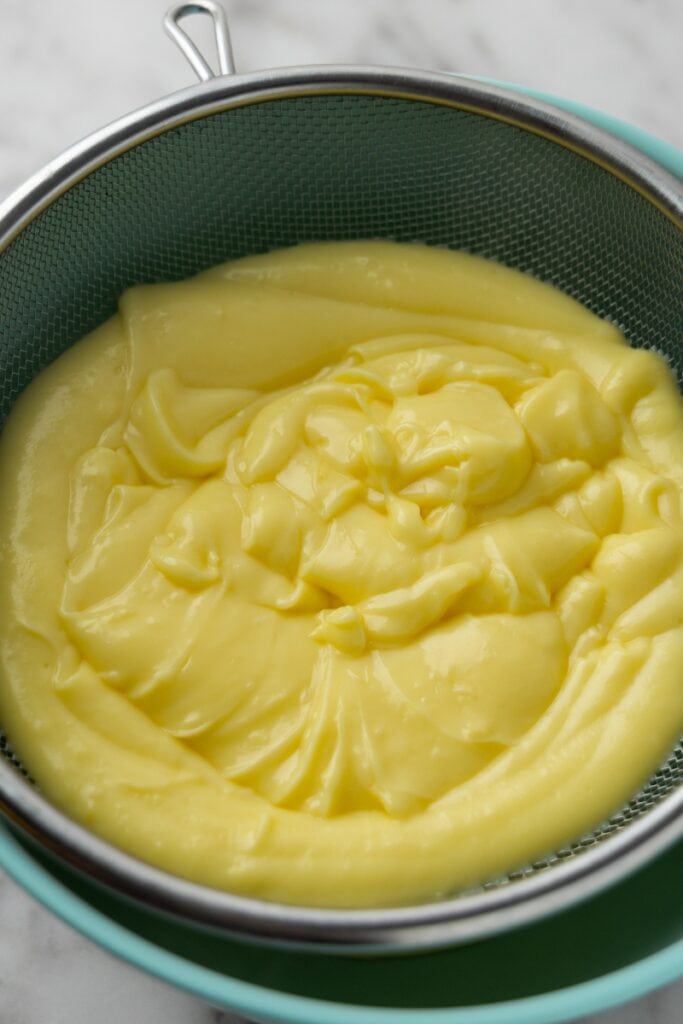Lemon Meringue Eclairs
This post may contain affiliate links. Read our privacy policy.
If you love lemon desserts, you’ve got to try these lemon meringue eclairs. You’ll love the perfect blend of tangy lemon and sweet meringue.

Recipe At a Glance
Lemon meringue is a classic flavor combination, and this recipe brings it to eclairs. We’ll use lemon pastry cream as our filling and top our eclairs with Italian meringue because it’s stable without baking.
The eclairs and pastry cream are straightforward to make. The Italian meringue is a bit more challenging because you’ll need a food thermometer to get the temperature just right. Once the meringue is done, it’s smooth sailing.
As for time commitment, lemon meringue eclairs aren’t a quick dessert you can whip up on short notice. If you make them in one go, you’ll need about 2 hours from start to finish. Alternatively, you could prepare the pastry cream and Italian meringue the day before baking the eclairs and assembling the dessert.
Making lemon meringue eclairs for the first time? Read the ingredients notes, step-by-step instructions, and tips. If you’re familiar with the recipe, feel free to jump to the recipe card.

Ingredients Notes and Substitutes
Lemon Pastry Cream
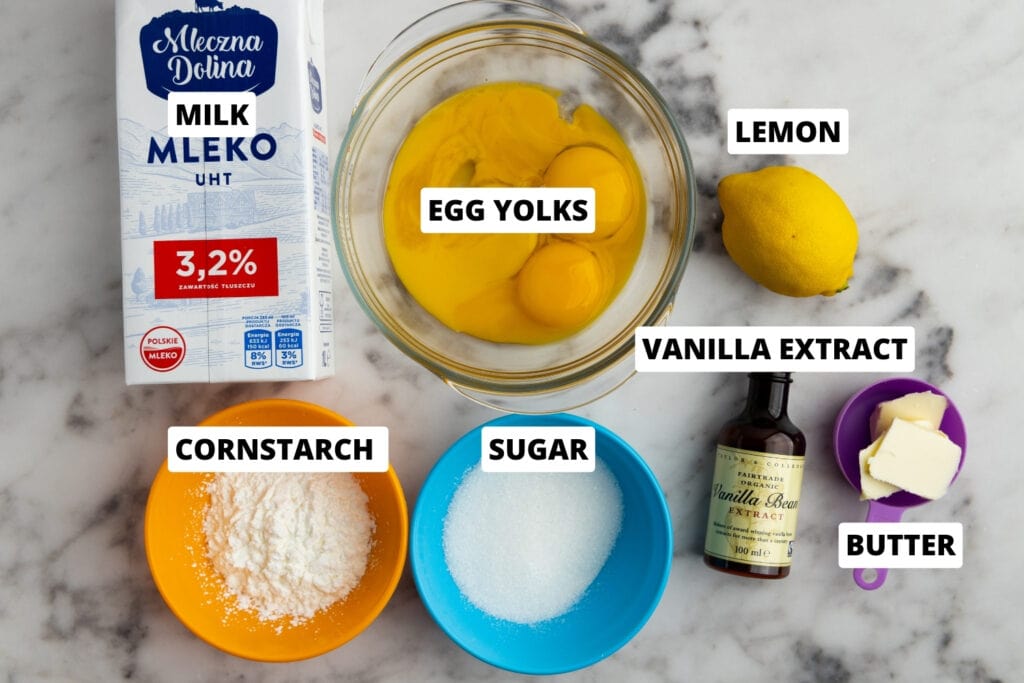
- Milk. Whole fat works best.
- Lemons. Choose blemish-free ones as we’re going to both juice and zest them.
- Sugar. Regular white sugar works well, but feel free to use any sweetener you like.
- Cornstarch. Cornstarch is best, but you can also use potato starch; just halve the amount. Check out my article on cornstarch versus potato starch for more details.
- Egg Yolks.
- Vanilla Extract. Helps add more flavor but it’s okay to skip it.
Italian Meringue

- Egg whites. Ensure there is no egg yolk residue in your whites, or the meringue won’t whip and hold its shape properly. If an egg yolk breaks when separating it from the white, store that egg separately and use it for something else. Wash your hands and any equipment that touches the yolk before continuing. Leave the whites at room temperature for at least an hour before you whip them.
- Water.
- Granulated sugar. Regular granulated white sugar is fine, as we’ll melt it in hot water before adding it to the meringue.
- Lemon juice. Lemon juice helps stabilize the egg whites. Alternatively, you can use white vinegar, but reduce the amount to 1/4 of the lemon juice.
- Cream of tartar. Another stabilizer. It’s okay to skip it if you’re adding lemon juice.
- Vanilla extract. Optional, but it improves the flavor.
Choux Pastry for Eclairs
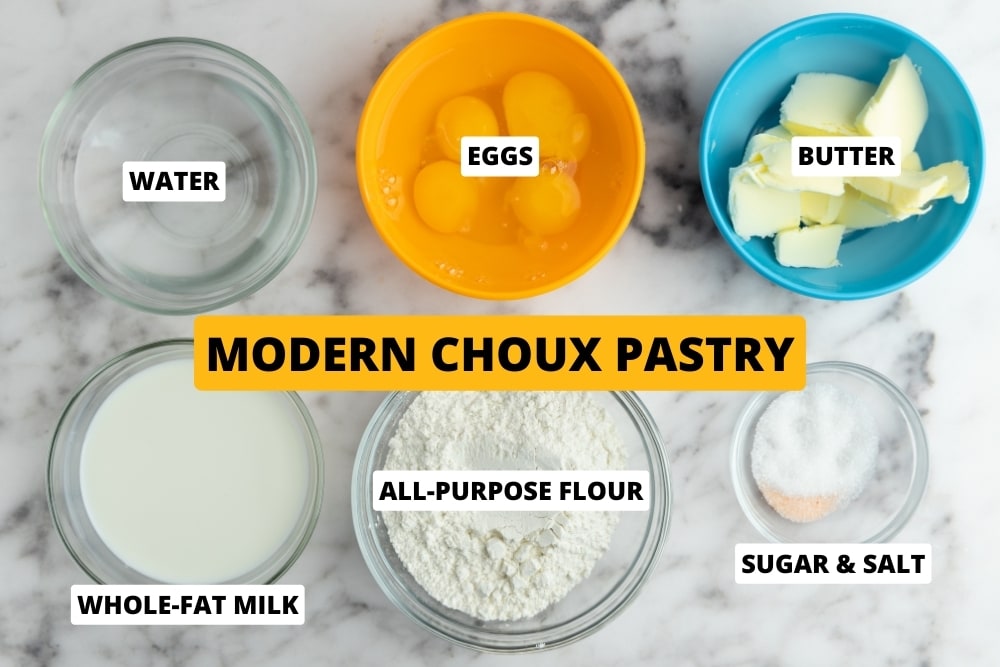
- Water and milk. Full-fat milk works best, but skim should work in a pinch.
- All-purpose flour.
- Unsalted butter.
- Eggs.
- Salt and sugar. Sugar alternatives are perfectly fine.
How to Make Lemon Meringue Eclairs
Here’s our high-level game plan:
- Cook lemon pastry cream. Start with the pastry cream, so it has time to cool before piping it inside the eclairs. You can also cook it the day before assembly. The recipe calls for steeping the milk with lemon zest, which you can do earlier in the day or spend that time working on the eclair dough.
- Make choux pastry and bake eclairs. Prepping and baking the eclairs is our next step.
- Whip Italian meringue. While the eclairs bake, we can whip the meringue. The meringue is ready to use right after whipping but can also sit in the fridge for a day or so, so it’s up to you when to make it.
- Assembly. Once we have our three components ready, all that’s left is to combine them.
Got it? Let’s jump right in.
Step 1: Cook Lemon Pastry Cream
(Check out our lemon pastry cream article for more tips on this pastry cream.)
- Wash lemons. First, rinse your lemons under running water. Then, if you’re using commercial lemons and want to remove (some) pesticides, soak the lemons for 15 minutes in 2 cups of water mixed with a tablespoon of baking soda.
- Zest and juice the lemons. Gently peel off the lemon zest using a microplane, a zester, or the fine holes on your box grater, avoiding discolored or blemished areas. If using a zester, chop the zest so you don’t have long strips of zest. Once you’re done with zesting, juice the lemons.
 Use microplane to scrape off lemon zest
Use microplane to scrape off lemon zest Squeeze out the juice from the lemon and set aside
Squeeze out the juice from the lemon and set aside
- Infuse milk. Combine the lemon zest and remaining milk in a pot and set it over medium-high heat. Heat it until bubbles form around the edges of the pot, indicating that it’s nice and warm. Then, turn off the heat and let it steep for 20 to 30 minutes before continuing.
 Mix lemon zest and remaining milk
Mix lemon zest and remaining milk Heat until bubbles form around the edges
Heat until bubbles form around the edges and steep for 20-30 minutes
and steep for 20-30 minutes
- Prepare egg mixture. In a heatproof bowl, combine egg yolks, sugar, and cornstarch. Whisk until well combined.

- Boil milk. After 20 to 30 minutes of steeping, add vanilla extract to the infused milk, bring it back to a boil, and take it off the heat.
- Temper the yolk mixture. Gradually pour a couple of tablespoons of the hot milk into the yolk mixture, constantly whisking to prevent the yolks from curdling. Repeat this process three to four times until you’ve incorporated most of the milk. Keep stirring throughout.
 Gradually pour warm milk into the egg mixture
Gradually pour warm milk into the egg mixture Stir until milk is fully incorporated
Stir until milk is fully incorporated
- Cook until thick and bubbly. Return the egg mixture to the pot you used for the milk. Cook it over low or medium heat, stirring constantly, until it noticeably thickens and starts to bubble when you stop stirring for a moment. This typically takes 3 to 5 minutes, depending on the pot and heat intensity. Avoid rushing the process to prevent the yolks from curdling.
 Return the egg mixture to the pot
Return the egg mixture to the pot Cook until the mixture thickens
Cook until the mixture thickens
- Take off the heat and whisk. Once the mixture is thick, remove the pot from the heat and continue whisking for about a minute, bringing the mixture past the point of maximum thickness.
- Stir in butter. Add the butter to the pot and stir until it melts and integrates into the cream.
 Add the chopped butter
Add the chopped butter Stir until butter is incorporated
Stir until butter is incorporated
- Add lemon juice. Stir in the lemon juice.
- Taste test. Sample the cream (be cautious; it’s hot) and add more sugar or lemon juice if necessary.
- (Optional) Strain. If you want to get rid of the lemon zest or there are lumps or cooked egg bits in your pastry cream, pour it through a strainer into a bowl to achieve a uniform texture.
 Strain pastry cream to remove
Strain pastry cream to remove zest, lumps, or cooked egg bits
zest, lumps, or cooked egg bits
- Cover and chill. Place plastic wrap directly on the surface of the pastry cream to prevent a crust from forming. Leave it at room temperature for at least 30 minutes to cool slightly. Then refrigerate (covered) until you’re ready to use it.

Step 2: Make and Bake Eclairs
(Read my articles on choux pastry and eclairs for more tips.)
- Preheat oven. Preheat your oven to 390°F (200°C).
- Melt butter and bring to a boil. In a pot, combine butter, milk, water, salt, and sugar, then bring the mixture to a boil, ensuring the butter is fully melted.
 Add butter to the pot
Add butter to the pot Boil it with water, milk, salt and sugar
Boil it with water, milk, salt and sugar
- Add Flour. Take the pot off the heat, add all the flour to the mixture at once, and stir until it roughly combines. Bring the pot back to the stove and continue stirring with a spoon over low heat. The dough will thicken and clump quickly, but you should continue stirring the mixture for 2-3 minutes, ensuring all the flour is incorporated and no white floury spots are inside. While stirring, scrape the dough from the sides and bottom to prevent sticking. After 2-3 minutes, the dough should be glossy and easy to detach from the pot, and a thin layer, or film, should form on the bottom.
 Add flour to the mixture
Add flour to the mixture Stir and cook over low heat
Stir and cook over low heat Thin layer of dough on the pot’s base
Thin layer of dough on the pot’s base
- Transfer. Move the dough to a mixing bowl and let it cool for about 10 minutes. Spreading it across the bowl can speed up cooling.
- Prepare Eggs. Crack the eggs into a separate bowl and whisk them.
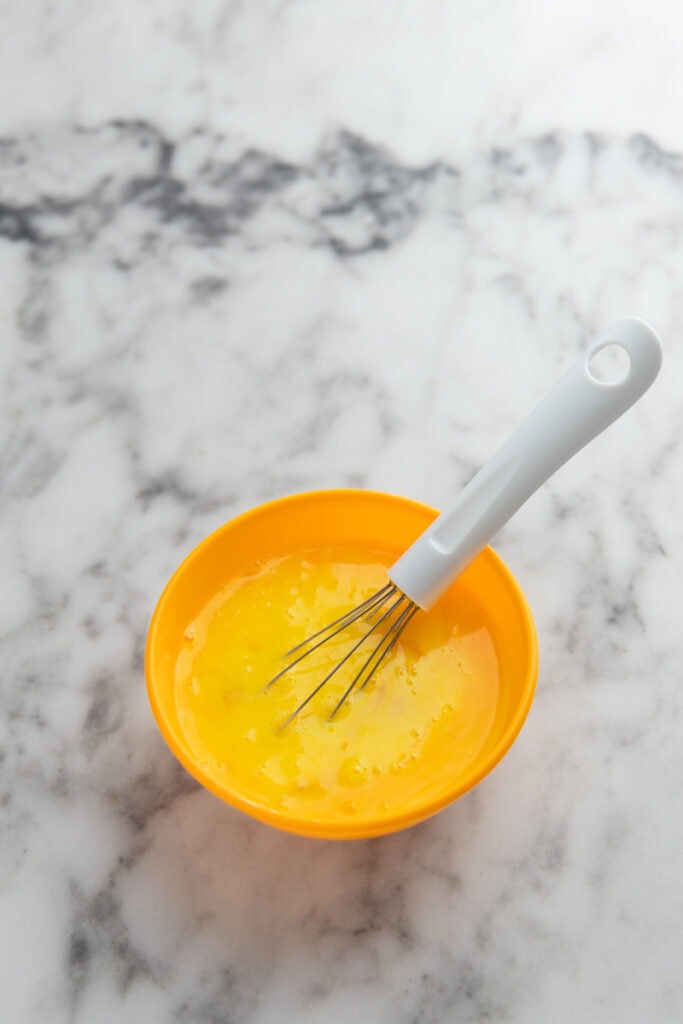
- Make Dough. Once the dough has cooled slightly, start mixing it with a hand mixer at medium speed. After 20-30 seconds of mixing, add half the eggs to the dough and mix until incorporated. Repeat by adding half of the leftover egg mixture. Now it’s time to get the dough to the right consistency: you want it thick enough to hold its shape but still pipeable. The V-Shape test is the best way to check for that: Dip your mixer whisks or spatula into the dough and lift it. The dough should slowly fall off, eventually leaving a piece of dough hanging that forms a characteristic ‘V’ shape or a triangle at the end of the whisk or spatula. If the dough is not there yet, continue adding the eggs bit by bit and checking the consistency.

 After falling off
After falling off the remaining dough should
the remaining dough should form a v-shape
form a v-shape
- Prepare Baking Tray. Line a baking tray with parchment paper or a silicone mat. If you could use a guide for piping, draw straight 4- to 5-inch long lines (or 2.5- to 3-inch ones for mini eclairs) on the underside of the parchment paper as a guide, spaced about 2 inches apart. That will help you make the eclairs straight and of uniform length. Some baking mats already have the eclair shape on them, so consider buying one if you often bake eclairs.
- Piping Prep. Transfer the dough into a piping bag fitted with a large tip. I use a Wilton 6B, which has an opening of approximately 15mm in diameter (a bit more than half an inch). Alternatively, use a plastic food bag with a corner cut off.
- Pipe. Pipe the dough onto the prepared baking tray, forming strips about an inch wide and 4-5 inches long (or 2.5 to 3 inches for mini eclairs), leaving more than an inch of space between each strip to allow for expansion. Hold the piping bag at a 45-degree angle and pipe the eclair in one slow and smooth action. If the end of the eclair has an irregular shape that bothers you, you can smooth it out using wet fingers.

- Bake. Place the tray in the preheated oven, then immediately reduce the temperature to 356°F (180°C). Bake for 40 minutes (30 to 35 for mini eclairs). Open the door a tiny bit (and leave them open) for the last 5 minutes for any buildup steam to escape. If the eclairs start to brown before the 35-minute (25- for minis) mark, lower the temperature to 320°F (or 160°C).

- Cool. Remove the eclairs from the oven, let them cool for 10 minutes, then carefully detach them from the parchment paper or silicone mat and let them cool on a wire rack for another 10 minutes before piping and filling.

Step 3: Make Italian Meringue
- Cook water and sugar mixture. Combine sugar and water in a saucepan over medium heat. Don’t rush the process by using high heat. When the mixture is pretty hot (but not yet boiling), stir gently until all the sugar dissolves. Then, bring the mixture to a boil.
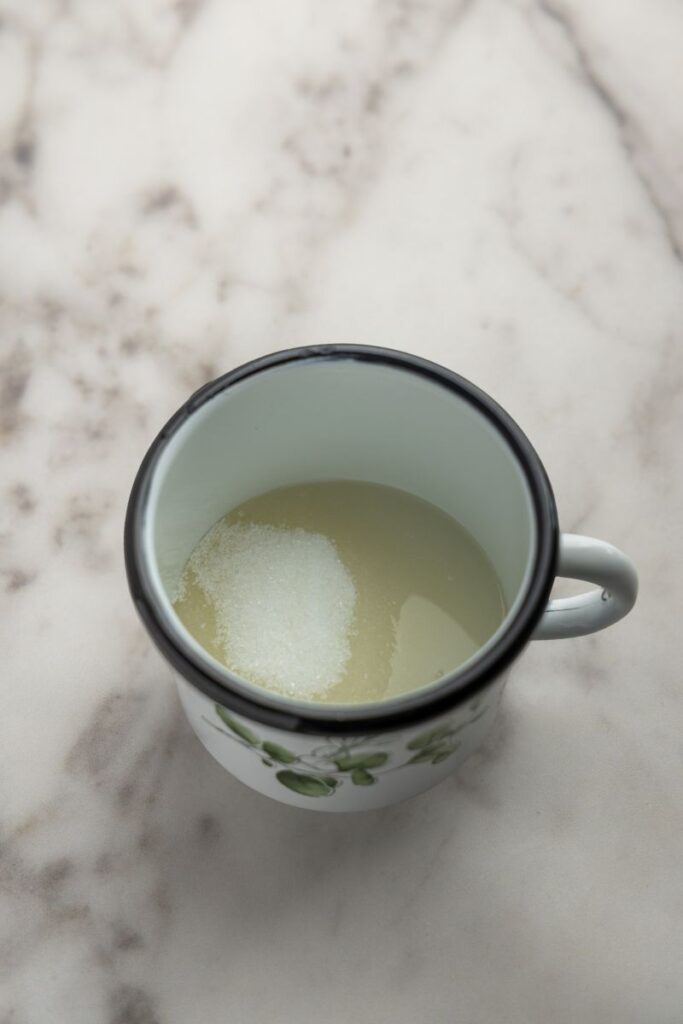
- Prep for whipping. While the sugar syrup heats up, combine the egg whites, lemon juice, and cream of tartar in your stand mixer bowl so they’re ready when needed.
- Continue cooking sugar syrup. Once the mixture starts bubbling, increase the heat to medium-high. Place a digital thermometer in the pot and wait until the mixture reaches 220-230°F (105-110°C). No stirring.
- Whip whites. When the mixture reaches the mentioned temperature, start whipping the egg whites. Begin at low speed for about 30 seconds, then increase to the highest speed until soft peaks form. Aim to have the whites ready around the same time the sugar syrup is ready.

- Cook syrup until it reaches 244°F (118°C). While the whites are being whipped, the sugar syrup temperature should slowly rise (increase to high heat if it takes too long). It must reach 244°F (118°C) before pouring into the whites. If your whites reach soft peaks and the syrup needs more time, turn off the mixer to avoid overwhipping. Once the syrup reaches the correct temperature, remove it from heat and let the aggressive bubbling subside before proceeding. 20 to 30 seconds is usually enough.
- Combine whites and sugar syrup. Set your mixer to high speed and slowly pour the sugar syrup into the egg whites in a steady stream. Avoid the sides of the bowl (so the syrup won’t end up on the bottom), and avoid the whisk attachment to prevent the hot syrup from splattering (and burning yourself). Once done, add the vanilla extract if using.
- Whip until no longer hot. Switch the mixer to medium speed and whip until the bowl is only slightly warm, and the meringue is stiff and shiny, usually taking about 4 to 7 minutes. The meringue is now ready.
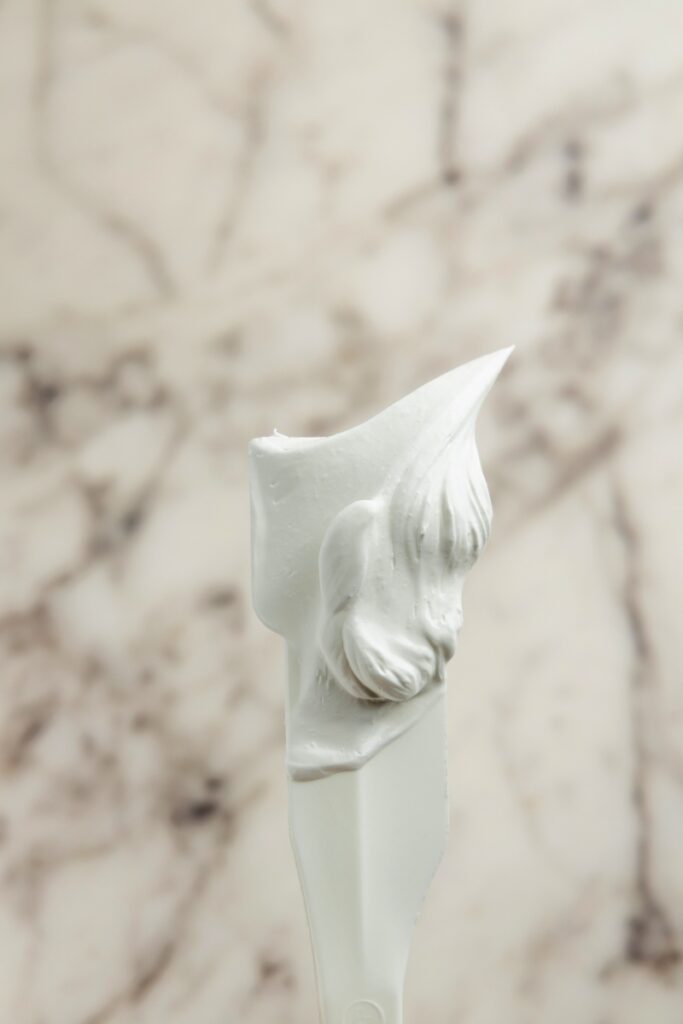
- Refrigerate or use. Transfer the meringue to an airtight container and refrigerate if you’re not using it soon.

Step 4: Assembly
- Prep eclairs for piping. Using a small round piping tip, gently poke three holes (two for minis) in the sides of each eclair, ensuring the holes are large enough for the piping tip. Alternatively, you can use a paring knife. These holes will allow us to pipe the filling inside the eclairs. If you prefer, slice each eclair in half horizontally with a serrated knife, creating a top and bottom.

- Whisk pastry cream. If the pastry cream has been refrigerated, it will have a stiff, pudding-like texture. This is normal. To use it, “chop” it up with a fork, then switch to a whisk and stir for a minute or two until it becomes smooth.
 Chop up the chilled pastry cream
Chop up the chilled pastry cream Whisk for a minute until the texture is smooth
Whisk for a minute until the texture is smooth
- Fill eclairs. Transfer the whisked pastry cream to a piping bag or syringe and gently fill each eclair, stopping when the cream starts coming out of other holes or through the cracks.
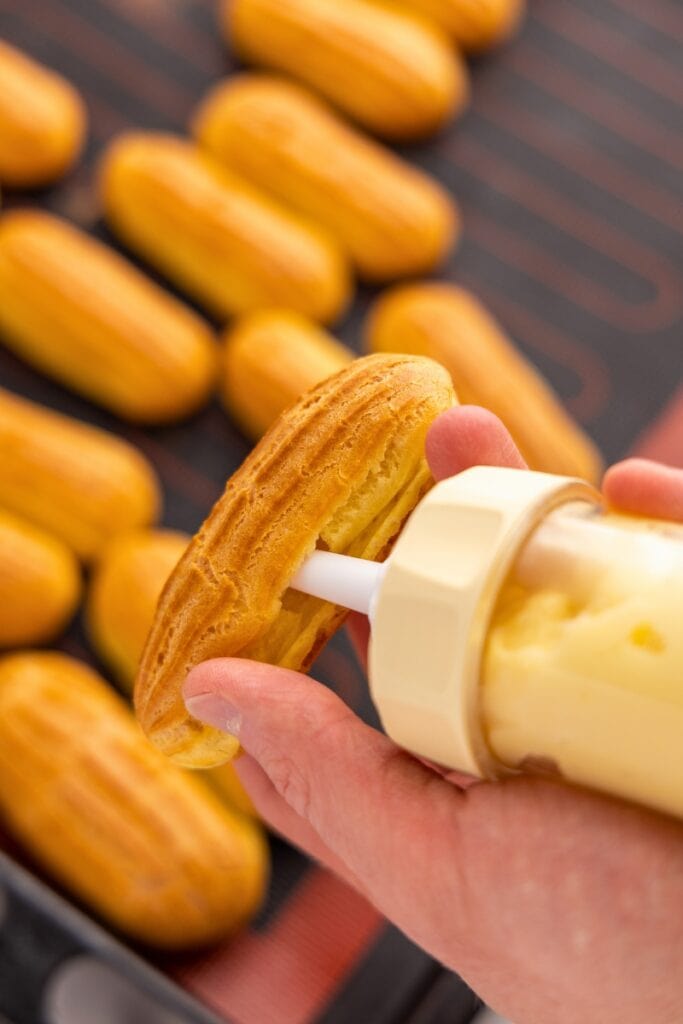
- Pipe meringue. Transfer the meringue into a piping bag or syringe and pipe onto the tops. To decorate as I did, use a petal tip and pipe the meringue at a slight angle, starting at the end farthest from you, moving left to right and back in a continuous motion until reaching the other end. Ensure the wider end of the tip faces downward.
- (Optional) Torch the meringue. Using a kitchen torch, lightly brown the meringue for a toasted finish.
- Serve or refrigerate. Serve right away or refrigerate until needed.

Tips
- Clean your whipping tools thoroughly. If you’ve ever had issues with egg whites not whipping properly, it was likely due to oily residue from the egg yolks or your equipment. To ensure everything is squeaky clean, use white vinegar to wipe down the saucepan and thermometer you’ll use to cook the sugar syrup, as well as the mixer bowl, whisk attachment, and spatula you’ll use for whipping.
- Avoid crystallization. When making the sugar syrup, we want to avoid crystallization to keep the meringue smooth and glossy. That’s why we avoid stirring the syrup, only stirring a bit at the beginning to help dissolve the sugar. If you see sugar crystals forming on the sides of the saucepan, use a wet pastry brush to gently brush the crystals down into the syrup. We also use this technique when making caramel, like in caramel pastry cream.
- Use a stand mixer. A stand mixer is really handy when making Italian meringue. You could do this by hand, but it requires more coordination to whip the meringue while watching the temperature of the sugar syrup. Plus, there’s a lot of whipping involved. Go with a hand mixer if you could use an arm workout.

Variations
Simplify
- Substitute lemon curd for lemon pastry cream. Lemon curd is another option for the filling. If you want to use my recipe, double the ingredients, but use two whole eggs and three egg yolks instead of 4 whole eggs. This way, you’ll have three leftover whites, perfect for making the meringue. Plus, the curd will be thicker and less likely to seep from the eclairs. If it still turns out a bit too thin, pipe it from the top of the eclairs instead of the bottom.

Storage
You can store these eclairs in the fridge for 3 to 4 days. However, they’re best enjoyed the day they’re baked, as they lose their crispness by the next day. The meringue might also start to deflate slightly after 2 to 3 days of refrigeration. Always make sure the container is sealed tightly so they don’t absorb any odors.
Recipes to Try
Looking for more? Here are a few ideas:
- Eclair fillings. Looking for a filling for your next eclairs? Here’s a handy list.

Equipment
- Stand mixer
- Digital thermometer
Ingredients
Lemon Pastry Cream:
- 1 3/4 cups milk ~420g
- 2 lemons medium
- 4 egg yolks medium or large (about 60-70g)
- 4 tablespoons cornstarch ~40g
- 7 tablespoons sugar ~87g
- 1 teaspoon vanilla extract
- 2 tbsp unsalted butter ~28g
Eclairs:
- ¼ cup water ~60 ml
- ¼ cup milk ~60 ml
- 3 tbsp unsalted butter ~45 g
- 2½ oz all-purpose flour ~70 g
- ¼ tsp salt
- 1¼ tsp sugar
- 2 large eggs ~95g after cracking
Meringue:
- 3 egg whites about 90 – 100g, at room temperature
- 1 cup granulated sugar 200g
- 100 g water 1/2 cup – 1 tablespoon
- 1 teaspoon lemon juice
- 1 teaspoon vanilla extract optional
- 1/2 teaspoon cream of tartar optional
Instructions
Lemon Pastry Cream:
- Wash Lemons: Rinse under running water and optionally soak in a baking soda solution to remove pesticides.
- Zest and Juice: Use a microplane or zester to remove the zest, then juice the lemons.2 lemons
- Infuse Milk: Heat the milk with lemon zest until bubbles form at the edges, then turn off the heat and let it steep for 20-30 minutes.1 3/4 cups milk
- Mix Egg Ingredients: Whisk together egg yolks, sugar, and cornstarch in a heatproof bowl.4 egg yolks, 7 tablespoons sugar, 4 tablespoons cornstarch
- Boil Milk: Reheat the infused milk with added vanilla extract to a boil, then remove from heat.1 teaspoon vanilla extract
- Temper Yolks: Slowly add hot milk to the egg mixture, whisking constantly to avoid curdling.
- Cook Cream: Return the mixture to the pot and cook on low heat, stirring constantly until thickened and bubbly.
- Finish Cream: Remove from heat and whisk for an additional minute.
- Add Butter and Lemon Juice: Stir in butter until melted, then add the lemon juice.2 tbsp unsalted butter
- Taste and Adjust: Test the flavor and adjust sweetness or tanginess as needed.
- Strain (Optional): Strain to remove zest or any lumps for a smoother texture.
- Cool and Chill: Cover with plastic wrap touching the surface and cool at room temperature for at least 30 minutes, then refrigerate if not using soon.
Eclairs:
- Preheat Oven: Heat oven to 390°F (200°C).
- Boil Butter Mixture: In a pot, mix butter, milk, water, salt, and sugar. Bring to a boil, ensuring the butter melts completely.¼ cup water, ¼ cup milk, 3 tbsp unsalted butter, ¼ tsp salt, 1¼ tsp sugar
- Add Flour: Off the heat, add flour and stir. Return to low heat, stirring continuously for 2-3 minutes until the dough is thick and glossy and leaves a thin film on the pot bottom.2½ oz all-purpose flour
- Cool Dough: Transfer dough to a bowl and let it cool for 10 minutes, spreading it out to cool faster.
- Whisk Eggs: Beat eggs in a separate bowl.2 large eggs
- Mix Dough: Once the dough has slightly cooled, mix it with a hand mixer. Gradually add half the eggs, mix, and then add the remaining eggs bit by bit until the dough forms a 'V' shape when lifted with a whisk or spatula.
- Prepare Tray: Line a baking tray with parchment or a silicone mat. Optionally, draw 4- to 5-inch lines with 2 inches in between on the parchment as a guide for piping.
- Piping Prep: Fill a piping bag with a large tip with the eclair dough.
- Pipe: Pipe the dough into strips on the tray, spaced more than an inch apart. Smooth any irregular ends with wet fingers.
- Bake: Bake in a preheated oven at 356°F (180°C) for 40 minutes (30 to 35 minutes for minis), reducing the temperature if the eclairs start to brown prematurely, and open the oven door slightly for the last 5 minutes to release steam.
- Cool: Let eclairs cool on the tray for 10 minutes, then transfer to a wire rack to cool completely before filling.
Meringue:
- Cook Syrup: Combine sugar and water in a saucepan over medium heat. Once hot, stir gently until the sugar dissolves. Then, bring to a boil.1 cup granulated sugar, 100 g water
- Whipping Prep: Combine egg whites, lemon juice, and cream of tartar in a stand mixer bowl.3 egg whites, 1 teaspoon lemon juice, 1/2 teaspoon cream of tartar
- Continue Cooking Sugar Syrup: Once boiling, increase heat to medium-high. Heat the syrup until the mixture reaches 220-230°F (105-110°C) without stirring.
- Whip Whites: Start whipping egg whites on low speed for 30 seconds, then increase to high and whip until soft peaks form.
- Cook Syrup: Heat the syrup to 244°F (118°C). If the whites are ready first, turn off the mixer. Once it reaches the given temperature, let the syrup sit for 20-30 seconds off heat before continuing.
- Combine: Set the mixer to high and slowly pour the syrup into the egg whites. Avoid the bowl sides and the whisk. Add vanilla extract if using.1 teaspoon vanilla extract
- Whip: After adding the sugar syrup and vanilla, switch to medium speed and whip until the meringue is stiff and shiny and the bowl is no longer hot, about 4-7 minutes.
Assembly:
- Eclair Prep: Poke three holes in the bottom of each eclair with a small round piping tip or paring knife. Alternatively, slice each eclair in half horizontally.
- Prep Pastry Cream: If refrigerated, stir pastry cream with a fork, then whisk until smooth.
- Pipe Eclairs: Fill a piping bag with pastry cream and fill each eclair until full.
- Pipe Meringue: Fill a piping bag with meringue and pipe onto the eclair tops.
- (Optional) Torch Meringue: Lightly brown the meringue with a kitchen torch.
- Serve: Serve immediately or refrigerate until needed.












